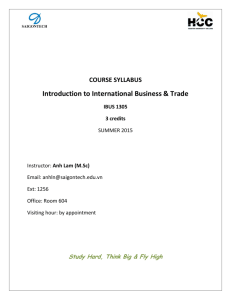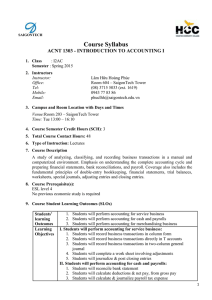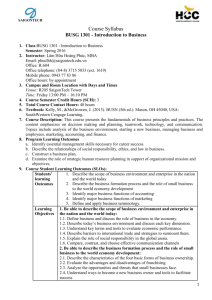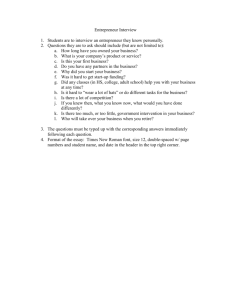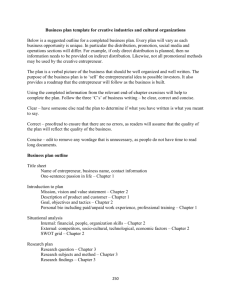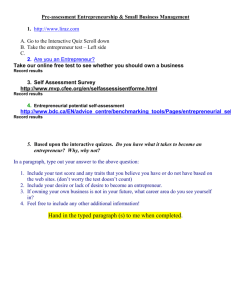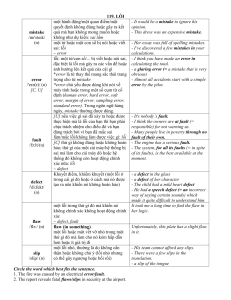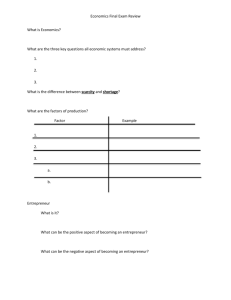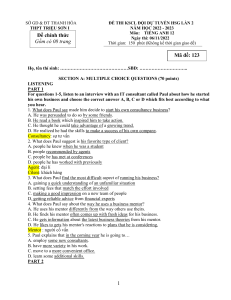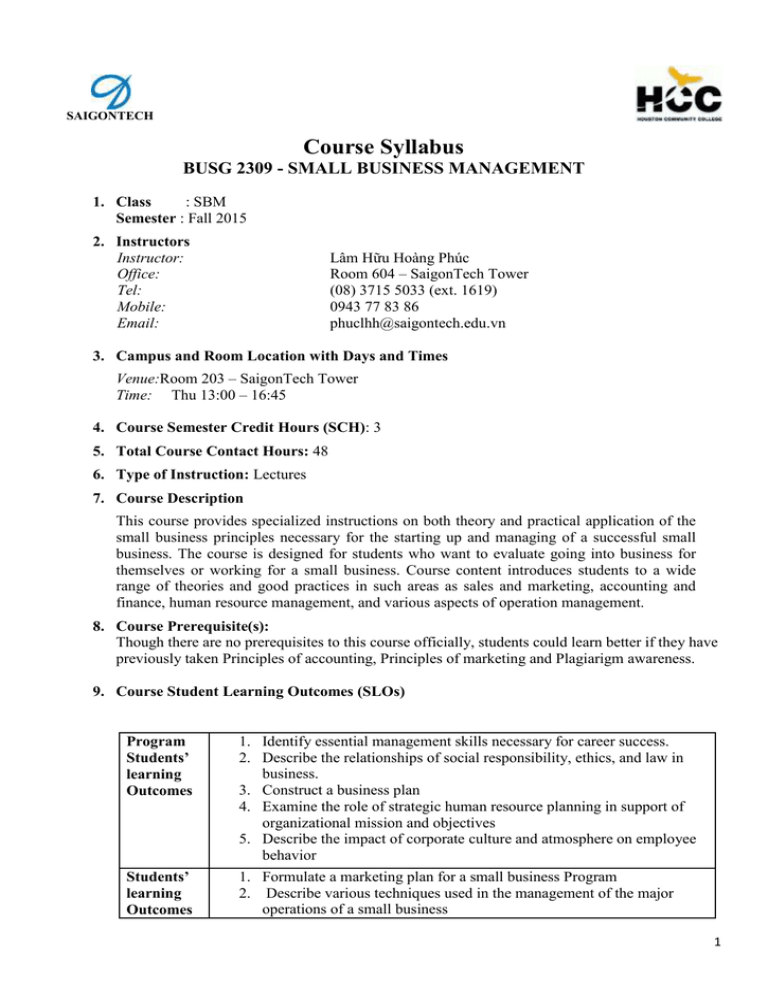
SAIGONTECH
Course Syllabus
BUSG 2309 - SMALL BUSINESS MANAGEMENT
1. Class
: SBM
Semester : Fall 2015
2. Instructors
Instructor:
Office:
Tel:
Mobile:
Email:
Lâm Hữu Hoàng Phúc
Room 604 – SaigonTech Tower
(08) 3715 5033 (ext. 1619)
0943 77 83 86
phuclhh@saigontech.edu.vn
3. Campus and Room Location with Days and Times
Venue:Room 203 – SaigonTech Tower
Time: Thu 13:00 – 16:45
4. Course Semester Credit Hours (SCH): 3
5. Total Course Contact Hours: 48
6. Type of Instruction: Lectures
7. Course Description
This course provides specialized instructions on both theory and practical application of the
small business principles necessary for the starting up and managing of a successful small
business. The course is designed for students who want to evaluate going into business for
themselves or working for a small business. Course content introduces students to a wide
range of theories and good practices in such areas as sales and marketing, accounting and
finance, human resource management, and various aspects of operation management.
8. Course Prerequisite(s):
Though there are no prerequisites to this course officially, students could learn better if they have
previously taken Principles of accounting, Principles of marketing and Plagiarigm awareness.
9. Course Student Learning Outcomes (SLOs)
Program
Students’
learning
Outcomes
1. Identify essential management skills necessary for career success.
2. Describe the relationships of social responsibility, ethics, and law in
business.
3. Construct a business plan
4. Examine the role of strategic human resource planning in support of
organizational mission and objectives
5. Describe the impact of corporate culture and atmosphere on employee
behavior
Students’
learning
Outcomes
1. Formulate a marketing plan for a small business Program
2. Describe various techniques used in the management of the major
operations of a small business
1
Learning
Objectives
3. Describe the relationship of social responsibility, ethics and law in
business
4. Construct a business plan Program SLO # 3 All chapters 5 Describe the
importance of HR planning, and its influence on the company culture to
support the entrepreneur's mission and goals
5. Explain how to build the kind of company culture and structure to
support the entrepreneur's mission and goals and to motivate employees
to achieve them.
1. Formulating a marketing plan for a small business:
1.1 Describe the components of a guerrilla marketing plan and explain the
benefits of preparing one.
1.2 Describe the guerrilla marketing strategies on which a small business can
build a competitive edge in the marketplace.
1.3 Discuss the “four Ps” of marketing—product, place, price, and
promotion—and their role in building a successful marketing strategy.
1.4 Define your company’s unique selling proposition (USP).
1.5 Explain the differences among promotion, publicity, personal selling, and
advertising.
1.6 Describe the advantages and disadvantages of the various advertising
media.
2. Describing various techniques used in the management of the major
operations of a small business:
2.1 Explain the process of selecting a location for a retail, manufacturing, and
service firm.
2.2 Explain the principles of effective layouts for retailers, service businesses,
and manufacturers.
2.3 Understand the components of a purchasing plan.
2.4 Explain the principles of total quality management (TQM) and Six Sigma
and their impact on quality.
2.5 Conduct economic order quantity (EOQ) analysis to determine the proper
level of inventory.
2.6 Differentiate among the three types of purchase discounts that vendors
offer.
2.7 Calculate a company’s reorder point.
2.8 Explain the various inventory control systems and the advantages and
disadvantages of each.
2.9 Describe how just-in-time (JIT) and JIT II inventory control techniques
work.
2.10 Describe methods for reducing losses from slow-moving inventory.
2.11 Discuss employee theft and shoplifting and how to prevent them.
3. Describing the relationship of social responsibility, ethics and law in
business:
3.1 Define business ethics and describe the three levels of ethical standards.
3.2 Define social responsibility.
3.3 Understand the nature of businesses’ responsibility to the environment.
3.4 Describe businesses’ responsibility to employees, customers, investors, and
the community.
4. Constructing a business plan
4.1 Develop a strategic plan for a business using the nine steps in the strategic
planning process.
4.2 Discuss the characteristics of three basic strategies: low-cost,
2
differentiation, and focus.
4.3 Understand the importance of controls such as the balanced scorecard in
the planning process.
4.4 Describe the various methods used in the valuation of a business.
4.5 Describe the elements of a solid business plan.
4.6 Explain the “five Cs of credit” and why they are important to potential
lenders and investors reviewing business plans.
4.7 Describe how to use financial statements to manage a small business.
4.8 Create projected financial statements.
4.9 Conduct a breakeven analysis for a small company.
4.10 Construct a cash budget
4.11 Describe the various sources of debt capital and the advantages and
disadvantages of each.
4.12 Describe the various sources of equity capital available to entrepreneurs,
including personal savings, friends and relatives, angels, partners, corporations,
venture capital, and public stock offerings.
4.13 Describe the process of “going public,” as well as its advantages and
disadvantages.
V. Describe the importance of HR planning, and its influence on the
company culture to support the entrepreneur’s mission and goals
5.1 Describe the importance of hiring the right employees and how to avoid
making hiring mistakes.
5.2 Discuss the ways in which entrepreneurs can motivate their employees to
achieve higher levels of performance.
VI. Explain how to build the kind of company culture and structure to
support the entrepreneur’s mission and goals and to motivate employees
to achieve them.
6.1 Explain how to build the kind of company culture and structure to support
the entrepreneur’s mission and goals and to motivate employees to achieve
them.
6.2 Understand the potential barriers to effective communication and describe
how to overcome them.
10. Textbook
Entrepreneurship - Effective Small Business Management - An entrepreneurial approach, 11th
Edition (2014) By Norman M. Scarborough, Doug Wilson, Thomas W. Zimmerer, Pearson Prentice
Hall. ISBN: 978-0-13-350632-7.
11. Course Requirements
Make-up policy
Make-up test is not allowed. If any class session is canceled, the instructor will discuss with
the students to arrange a make-up class.
Attendance and Withdrawal Policies
Please read information about attendance and withdrawal policies on SaigonTech website:
http://www.saigontech.edu.vn/saigontech/english/general_academic.jsp?subid=37#6
12. Instructor’s Requirements
Classroom policy
3
Please be seated before lecture begins, and don't leave early without prior permission
since it is very distracting to me and your classmates. Arriving late or leaving early will
count as half of an absence.
Because it is distracting to other students and to me, you should keep mobile phones
off/silent, and not carry on private conversations.
Being active in class discussions and asking questions are highly encouraged.
To make best use of our scarce time, do NOT study for another exam, work for another
class, play games, or surf the Internet. If you are caught red-handed, you will be
dismissed from the class and your attendance for that class will be ABSENT. It also
reduces your participation grade.
Do not close your books or rustle your papers to signal the end of class. Pack up only
when I say I have done.
Academic Honesty
Students are responsible for conducting themselves with honor and integrity in fulfilling course
requirements. Zero will be given to student accused of scholastic dishonesty and plagiarism while
an “F” will be given in severe case. Please read my PowerPoint on “Cheating and Plagiarism”
and the following policies for more details about Academic Dishonesty Policy:
Acts of plagiarism include but are not limited to:
Submit other people’s works to get points (Nộp bài làm của người khác để lấy điểm cho
mình).
Copy words or ideas without citing source and author’s name (Sao chép từ hoặc ý tưởng
củangười khác mà không nêu nguồn tài liệu và tên tác giả được trích dẫn).
Do not use quotation marks for direct citation (Không đặt dấu ngoặc kép trong các trích dẫn
nguyên văn).
Cite the wrong source (Đưa thông tin sai về nguồn của một trích dẫn).
Change the wording but sentence structure without citing author’s name (Thay đổi từ ngữ
nhưng vẫn giữ nguyên cấu trúc câu của một nguồn tài liệu mà không nêu tên tác giả).
Borrow words/ phrases from a source without using quotation marks or with making
negligible change (Vay mượn từ/ cụm từ của một nguồn tài liệu mà không đặt dấu ngoặc kép
hoặc chỉ thay đổi chúng một cách qua loa).
Copy too many words or ideas that make up the most of personal work, regardless of whether
source and author’s name are cited (Sao chép quá nhiều từ ngữ hoặc ý tưởng từ một nguồn tài
liệu làm cho các ý tưởng đó chiếm phần lớn bài làm của mình, bất kể có nêu tên nguồn hoặc
tác giả hay không)
Copy information from Internet such as company information, market information etc. (Sao
chépthông tin từ Internet (thông tin công ty, thông tin thị trườngv.v)
Copy completely or partly from the text translated by translation tool such as Google
translation etc (sao chép nguyên văn, hoặc một phần từ các công cụ dịch thuật, chẳng hạn
Google Translation)
Cooperate with other students to do the exams, tests and other assignments without
permission of the Instructor (Cộng tác với sinh viên khác trong lúc làm bài thi/kiểm tra hoặc
trong các bài tập mà không được phép của giáo viên)
Use one assignment to submit for different classes without permission of the Instructor (Sử
dụng hoặc nộp cùng một bài làm cho nhiều lớp khác nhau mà không được phép của giáo viên
môn học)
Have other people do the exams, tests and other assignments for you (Đi thi hộ hoặc nhờ
người khác thi hộ mình trong kỳ thi/ kiểm tra hoặc làm giúp hay nhờ người khác làm bài tập
cho mình)
4
Other Student Information: Refer to SaigonTech’s website at www. saigontech.edu.vnfor
other students rights and responsibilities at the school
13. Grading Policies
An Incomplete may be given only for extenuating circumstances (i.e. family illness, accident,
and an unforeseen event occurring at exam time). The grading policy is summarized below:
Course Grading
1) Quiz (quantity: 12, mode: individual)
2) Participation
3) Mid-term exam
4) Final exam
5) Presentation
Total
24%
10%
20%
30%
16%
100%
Grading Scale
A 90 – 100
B 80 – 89
C 70 – 79
D 60 – 69
0 – 59
F
The passing grade of this course is D.
1) Quiz (individual, closed book, only calculator accepted)
Each student must attend the class to take the quizzes. If he/she is absent, there is no
other opportunity to make up. Mark of 0 will be given if not taking the quiz.
Specific time and date for the quizzes are specified in the course calendar. The duration of
each test is 10 minutes. There are 12 quizzes in total.
The quizzes will be provided in order to test students’ knowledge about the materials
provided in the previous lectures and to help students be prepared before mid-term and
final examinations.
The results and feedbacks will be received at the next class.
2) Examination Format (individual, only calculator accepted)
Exam
Midterm
Endterm
Type
MCT
Application
No. of
questions
60
2
MCT
Application
60
2
Points
60
40
Chapters
Mode
Duratio
n
Reading
time
1, 2, 3, 4, 5,
7, 8, 9, 10
Closed
-book
120
mins
5 mins
11, 12, 13,
14, 15
Closed
-book
120
mins
5 mins
60
40
90
3) Participation (individual): Participation mark depends on your diligence and activeness. To
get full mark (10%), you have to attend all 24 class-sessions and be very active in the class.
4) Presentation (individual): Choose your business and make the plan.
14. Course Calendar:
Week
Chapter
1
Course introduction – Assignments
Chapter 1: Entrepreneurs: The Driving
Force Behind Small Business
Chapter 2: Ethics and Social
Responsibility: Doing the Right Thing
Item/Description
1. Define the role of the entrepreneur in the
U.S. economy.
2. Describe the entrepreneurial profile.
3. Explain how entrepreneurs spot business
opportunities.
5
2
Chapter 4: Strategic Management and the
Entrepreneur
Chapter 7: Buying an Existing Business
3
Chapter 8: New Business Planning Process:
4. Describe the benefits of owning a small
business.
5. Describe the potential drawbacks of
owning a small business.
6. Explain the forces that are driving the
growth in entrepreneurship.
7. Put business failure into the proper
perspective.
8. Explain how small business owners can
avoid the major pitfalls of running a business.
9. Define business ethics and describe the
three levels of ethical standards.
10. Determine who is responsible for ethical
behavior and why ethical lapses occur.
11. Explain how to establish and maintain
high ethical standards.
12. Explain the difference between social
entrepreneurs and traditional entrepreneurs.
13. Define social responsibility.
14. Explain the nature of business’
responsibility to the environment.
15. Describe business’ responsibility to
employees.
16. Explain business’ responsibility to
customers.
17. Discuss business’ responsibility to
investors.
18. Describe business’ responsibility to the
community.
Chapter 4
1. Understand the importance of strategic
management to a small business.
2. Explain why and how a small business
must create a competitive advantage in the
market.
3. Develop a strategic plan for a business
using the ten steps in the strategic planning
process.
4. Discuss the characteristics of three basic
strategies: low-cost, differentiation, and
focus.
5. Understand the importance of controls such
as the balanced scorecard in the planning
process.
Chapter 5
1. Understand the advantages of buying an
existing business.
2. Understand the disadvantages of buying an
existing business.
3. Explain the four steps involved in the right
way to buy a business.
4. Describe the five steps of the deal stage for
buying a business the right way.
5. Understand the transition stage for buying a
business the right way.
Chapter 8
6
Feasibility Analysis, Business Modeling,
and Crafting a Winning Business Plan
Business Plan Project Report – Step 1 (10
points)
- Describe your products & services:
what are your value propositions?
- Perform Industry / sector analysis
using Porter's Five Forces Model
- Performing SWOT analysis
4
Chapter 14: Creating a Solid Financial Plan
(Students should bring laptops and/or
calculators)
Chapter 15: Managing Cash Flow
5
Chapter 16: Sources of Equity Financing
Chapter 17: Sources of Debt Financing
1. Present the steps involved in conducting a
feasibility analysis.
2. Identify the components of the business
model canvas and explain how to use them to
develop a viable business model.
3. Explain the benefits of an effective
business plan.
4. Describe the elements of a solid business
plan.
5. Explain the three tests every business plan
must pass.
6. Explain the "five Cs of credit" and why
they are important to potential lenders and
investors reading business plans.
7. Understand the keys to making an effective
business plan presentation.
Chapter 14
1. Understand the importance of preparing a
financial plan.
2. Describe how to prepare financial
statements and use them to manage the small
business.
3. Create projected financial statements.
4. Understand the basic financial statements
through ratio analysis.
5. Explain how to interpret financial ratios.
6. Conduct a break-even analysis for a small
company.
Chapter 15
1. Explain the importance of cash
management to the success of the small
business.
2. Differentiate between cash and profits.
3. Understand the five steps in creating a cash
budget and use them to build a cash budget.
4. Describe fundamental principles involved
in managing the “Big Three” of cash
management: accounts receivable, accounts
payable, and inventory.
5. Explain how bootstrapping can help a small
business avoid a cash crunch.
Chapter 16:
1. Explain the differences among the two
types of capital small businesses require:
fixed and working.
2. Describe the various sources of equity
capital available to entrepreneurs, including
friends and relatives, crowdsourcing,
accelerators, angels, corporations, venture
capital, and public stock offerings.
3. Describe the seven sources of funding that
the founders can contribute to their new
business.
4. Describe the types of businesses that attract
venture capital financing and explain the
7
6
Business Plan Project Report – Step 2 (10
points)
Review for Midterm
7
Mid-term examination
Solution and Revision
8
Chapter 9: Building a Bootstrap Marketing
Plan
Chapter 10: Creative Use of Advertising
and Promotion
9
Chapter 11 Pricing and Credit Strategies
criteria that venture capitalists use to decide
on their investments.
5. Explain the process, the advantages, and
challenges of making an initial public
offering.
Chapter 17
1. Describe the various sources of debt capital
and the advantages and disadvantages of each.
2. Explain the types of financing available
from nonbank sources of credit.
3. Discuss other possible methods of
financing growth.
4. Explain how to avoid becoming a victim of
a loan scam.
- Estimating your initial investment
requirements: fixed and long-term assets;
working capital; capital expenditure.
- Projecting monthly cash flow for the first
1 year.
- Evaluating the financial feasibility of the
project using Break-even point analysis,
NPV, IRR, payback period, and
profitability index.
- Estimating SG&A, and major balance
sheet items
Chapter 9
1. Describe the components of a bootstrap
marketing plan and explain the benefits of
preparing one.
2. Explain how small businesses can pinpoint
their target markets.
3. Explain how to determine customer needs
through market research.
4. Outline the steps in the market research
process.
5. Describe the bootstrap marketing strategies
on which a small business can build a
competitive edge in the marketplace.
6. Discuss the “four Ps” of marketing—
product, place, price, and promotion—and
their role in building a successful marketing
strategy.
Chapter 10
1. Define your company’s unique selling
proposition (USP).
2. Explain the differences among promotion,
publicity, personal selling, and advertising.
3. Describe the advantages and disadvantages
of the various advertising media.
4. Identify four basic methods for preparing
an advertising budget.
Chapter 11
1. Explain why pricing is both an art and a
8
Chapter 21: Staffing and Leading a
Growing Company
10
11
Business Plan Project Report – Step 3
Management Team and Marketing Plan (10
points)
- Describe how you will address the
following management issues: Who are
the key executives and what are their
skills / experiences? What are the
benefits of each executive to the
company? How the team is qualified to
operate the business? What are the
external management resources (if
any)? What are your human resourec
need?
- Describe how you will address the
following marketing issues: What are
your sales strategy? What are your
product strategy? What are your price
strategy? What are your promotion
strategy? What are your distribution
strategy?
Chapter 18: Location, Layout, and Physical
Facilities
Chapter 19: Supply Chain Management
Chapter 20: Managing Inventory
science.
2. Discuss the relationship among pricing,
image, competition and value.
3. Describe effective pricing strategies for
both new and existing products and services.
4. Explain the pricing techniques used by
retailers.
5. Explain the pricing techniques used by
manufacturers.
6. Explain the pricing techniques used by
service firms.
7. Describe the impact of credit on pricing.
Chapter 21
1. Explain the challenges involved in the
entrepreneur’s role as leader and what it takes
to be a successful leader.
2. Describe the importance of hiring the right
employees and how to avoid making hiring
mistakes.
3. Explain how to build the kind of company
culture and structure to support the
entrepreneur’s mission and goals and to
motivate employees to achieve them.
4. Understand the potential barriers to
effective communication and describe how to
overcome them.
5. Discuss the ways in which entrepreneurs
can motivate their employees to achieve
higher levels of performance.
Chapter 18
1. Explain the stages in the location decision.
2. Describe the location criteria for retail and
service businesses.
3. Outline the basic location options for retail
and service businesses.
4. Explain the site selection process for
manufacturers.
5. Discuss the benefits of locating a start-up
company in a business incubator.
Chapter 19
1. Understand the components of a
purchasing plan.
2. Explain the principles of total quality
9
12
13
14
Business Plan Project Report - Step 4 (10
points) Operating Plan
Describe your operating plan in addressing
the following issues: How do you plan your
physical location? What are your plan for
facilities and equipment? What are your
inventory requirement and who are the
your suppliers? What are your
manufacturing processes?
Review for Final Exam
Final examination
Solution and Feedback
management (TQM) including Lean, 5S, and
Six Sigma and their impact on quality.
3. Conduct economic order quantity (EOQ)
analysis to determine the proper level of
inventory.
4. Differentiate among the three types of
purchase discounts vendors offer.
5. Calculate a company’s reorder point.
6. Develop a vendor rating scale.
Chapter 20
1. Explain the various inventory control
systems and the advantages and
disadvantages of each.
2. Describe how just-in-time (JIT) and JIT II
inventory control techniques work.
3. Describe some methods for reducing loss
from slow-moving inventory.
4. Discuss employee theft and shoplifting and
how to prevent them.
- Chapter 12: Product and Promotion:
Creating and Communicating Value
- Mini Video case
Chapter 14: Management Motivation and
Leadership: Bringing Business to Life
- Mini Video case
Presentation and Final Submission (60
points)
10

